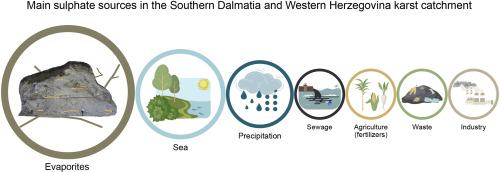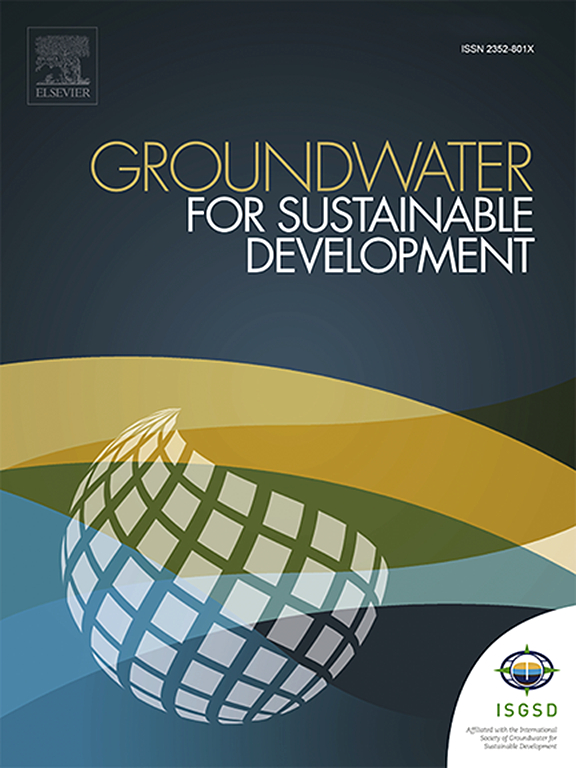利用多示踪剂方法调查硫酸盐污染:对复杂岩溶系统地下水水文地球化学特征的新见解
IF 4.9
Q2 ENGINEERING, ENVIRONMENTAL
引用次数: 0
摘要
岩溶环境,尤其是地中海地区的岩溶环境,极易受到自然和人为污染的影响。该研究首次在研究地区收集了六年的数据,综合了离子分析、硫同位素(δ34S)组成以及 30 个地点的水的物理化学分析。研究确定了受海水入侵、碳酸盐溶解、蒸发岩存在和人类活动影响的四种水文地质化学面貌(碳酸盐、硫酸盐、混合碳酸盐/硫酸盐和氯化物)。该研究建立了一个概念模型来解释硫酸盐的分布,强调了蒸发岩萃取和 δ34S 分析在追踪硫酸盐来源方面的重要性。这些发现有助于加深对岩溶系统的了解,并为地中海地区的地下水保护和立法措施提供重要数据。本文章由计算机程序翻译,如有差异,请以英文原文为准。

Utilizing a multi-tracer method to investigate sulphate contamination: Novel insights on hydrogeochemical characteristics of groundwater in intricate karst systems
Karst environments, especially in Mediterranean area, are highly vulnerable to natural and anthropogenic contamination. This study presents a comprehensive hydrogeochemical assesment of surface water and groundwater across a 2300 km2 catchment area spanning Southern Dalmatia (Croatia) and Western Herzegovina (Bosnia and Herzegovina).
For the first time in the study area, data were collected over six years integrating ion analysis, sulphur isotope (δ34S) composition, and physical-chemical analysis of water from 30 locations. The research identified four hydrogeochemical facies (carbonate, sulphate, mixed carbonate/sulphate and chloride), influenced by seawater intrusion, carbonate dissolution, evaporite presence, and human activities.
Elevated sulphate levels, often exceeding 250 mg/L, were a main focus of the study due to their potential risks to drinking water quality. The study developed a conceptual model to explain the distribution of sulphates, underscoring the importance of evaporite diapirism and δ34S analysis in tracing sulphate origins. These findings contribute to an improved understanding of karst systems and offer essential data for groundwater protection and legislative measures in the Mediterranean region.
求助全文
通过发布文献求助,成功后即可免费获取论文全文。
去求助
来源期刊

Groundwater for Sustainable Development
Social Sciences-Geography, Planning and Development
CiteScore
11.50
自引率
10.20%
发文量
152
期刊介绍:
Groundwater for Sustainable Development is directed to different stakeholders and professionals, including government and non-governmental organizations, international funding agencies, universities, public water institutions, public health and other public/private sector professionals, and other relevant institutions. It is aimed at professionals, academics and students in the fields of disciplines such as: groundwater and its connection to surface hydrology and environment, soil sciences, engineering, ecology, microbiology, atmospheric sciences, analytical chemistry, hydro-engineering, water technology, environmental ethics, economics, public health, policy, as well as social sciences, legal disciplines, or any other area connected with water issues. The objectives of this journal are to facilitate: • The improvement of effective and sustainable management of water resources across the globe. • The improvement of human access to groundwater resources in adequate quantity and good quality. • The meeting of the increasing demand for drinking and irrigation water needed for food security to contribute to a social and economically sound human development. • The creation of a global inter- and multidisciplinary platform and forum to improve our understanding of groundwater resources and to advocate their effective and sustainable management and protection against contamination. • Interdisciplinary information exchange and to stimulate scientific research in the fields of groundwater related sciences and social and health sciences required to achieve the United Nations Millennium Development Goals for sustainable development.
 求助内容:
求助内容: 应助结果提醒方式:
应助结果提醒方式:


